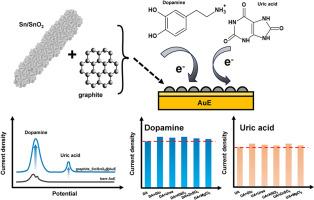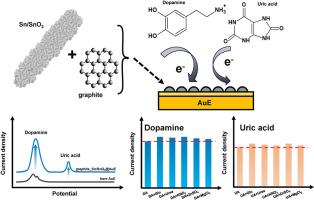微波等离子体处理锡/SnO2和石墨纳米复合材料协同促进对多巴胺和尿酸的电化学传感性能
IF 6
2区 化学
Q1 CHEMISTRY, ANALYTICAL
引用次数: 0
摘要
由于人体内的生物代谢异常,对生物分子的研究是必要的。多巴胺(DA)和尿酸(UA)是生物系统中共存的重要化学物质,在人体代谢的各种生理过程中起着至关重要的作用。本研究探索了碳和SnO2纳米颗粒在DA和UA传感中的应用,重点研究了通过静电纺丝和等离子体处理制备Sn/SnO2纳米复合材料。该研究旨在快速准确地测量这些浓度,从而提供低制造成本和环保等优势。结果本研究提出了一种新的Sn/SnO2纳米复合材料作为检测多巴胺(DA)和尿酸(UA)水平的电催化剂。在含SnCl2的静电纺纤维上,采用氩微波等离子体(ArMP)干燥绿色工艺,在120秒内有效制备了Sn/SnO2纳米复合材料。合成的Sn/SnO2纳米复合材料在定量DA和尿酸UA这两个重要生理分子水平方面具有良好的电化学催化作用。进一步将石墨掺入到腋窝- sn /SnO2中,可以调节DA、UA和抗坏血酸(AA)氧化峰的精确分化,解决生物分子间氧化电位重叠的问题。所建立的纳米复合材料显示出优异的适用性,可以结合到不同的衬底上,包括金电极(AuE)、丝网印刷碳电极(SPCE)和柔性碳电极(FCE),为建立即时检测平台提供了巨大的潜力。1%g-120s-腋窝- sn /SnO2@AuE对DA和UA的线性检测范围分别为0.1 ~ 400 μM和0.1 ~ 900 μM,灵敏度分别为473.72和169.21 μA/mM。测限分别为0.003 μM和0.010 μM。此外,在人体体液矩阵中,传感器的回收率在95.28% ~ 102.72%之间,在体液中存在常见干扰时具有高选择性(小于5%)。本文章由计算机程序翻译,如有差异,请以英文原文为准。


Microwave plasma treated Sn/SnO2 and graphite nanocomposites to synergistically promote electrochemical sensing performance toward dopamine and uric acid
Background
The investigation of biomolecules is essential due to abnormalities in biological metabolism in the human body. Dopamine (DA) and uric acid (UA) are important chemicals that coexist in biological systems and play crucial roles in various physiological processes related to human metabolism. This study explores the application of carbon and SnO2 nanoparticles for DA and UA sensing, focusing on the preparation of Sn/SnO2 nanocomposites through electrospinning and plasma treatment. The research aims to measure these concentrations quickly and accurately, offering advantages such as low manufacturing costs and environmental friendliness.
Result
This study presents a novel Sn/SnO2 nanocomposites as an electrocatalyst for the detection of dopamine (DA) and uric acid (UA) levels. Sn/SnO2 nanocomposites were effectively obtained by argon microwave plasma (ArMP) treatment, a dry and green process, on electrospun fibers containing SnCl2 within 120 s. The resultant Sn/SnO2 nanocomposites provide excellent electrochemical catalytic effects to quantify the levels of DA and uric acid UA, which are the two important physiological molecules. To further incorporate graphite into ArMP-Sn/SnO2 can modulate precise differentiation of the oxidation peaks of DA, UA, and ascorbic acid (AA), solving the problems of overlapped oxidation potential among biomolecules. The as-established nanocomposites revealed excellent applicability to be incorporated onto difference substrates including gold electrode (AuE), screen-printed carbon electrodes (SPCE), and flexible carbon electrodes (FCE), providing great potential for building point-of-care sensing platform.
Significance
The 1%g-120s-ArMP-Sn/SnO2@AuE resulting the highest sensing performance for DA and UA, which the linear detection range was 0.1–400 μM and 0.1–900 μM, with sensitivity of 473.72 and 169.21 μA/mM.cm2, and LOD 0.003 and 0.010 μM, respectively. Additionally, in the areal human fluid matrix the sensor obtains a recovery rate between 95.28 % and 102.72 % with a high selectivity (less than 5 %) upon the presence of common interferences in body fluid.
求助全文
通过发布文献求助,成功后即可免费获取论文全文。
去求助
来源期刊

Analytica Chimica Acta
化学-分析化学
CiteScore
10.40
自引率
6.50%
发文量
1081
审稿时长
38 days
期刊介绍:
Analytica Chimica Acta has an open access mirror journal Analytica Chimica Acta: X, sharing the same aims and scope, editorial team, submission system and rigorous peer review.
Analytica Chimica Acta provides a forum for the rapid publication of original research, and critical, comprehensive reviews dealing with all aspects of fundamental and applied modern analytical chemistry. The journal welcomes the submission of research papers which report studies concerning the development of new and significant analytical methodologies. In determining the suitability of submitted articles for publication, particular scrutiny will be placed on the degree of novelty and impact of the research and the extent to which it adds to the existing body of knowledge in analytical chemistry.
 求助内容:
求助内容: 应助结果提醒方式:
应助结果提醒方式:


